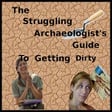
Puppy Problems - Episode 9
Welcome to Episode 9 of The Struggling Archaeologist’s Guide to Getting Dirty: Puppy Problems!
Now first off, I’d like to apologize for the content of this episode. There’s no way around it… I’m talking about dead puppies here. I mean they’re mummified puppies which is what makes it interesting, but, yeah- still pretty sad. But since I’m a dog lover and an exasperated dog owner, I turned this one into a discussion on the history of dog/human evolution because that’s pretty cool and stuff.
If you listen to the episode you’ll notice I talk a lot about stray dogs that stalk me and try to sneak into my house, like I won’t notice I have this strange dog hanging around. Like since there’s so many in there I would, like a crazy cat lady, probably not even notice. I wasn’t lying, and you can see the evidence on the original blog post for the episode here...
Alright, well that’s it for the puppy talk. In this week’s Shorty News we talk about this jerk from Canada who sparks another convo on relic hunting and the black market. And that’s it folks, make sure to listen to previous episodes here or on iTunes, and check out our new tumblr blog here!
McNiven OUT!





